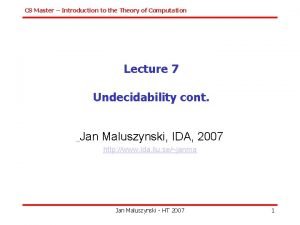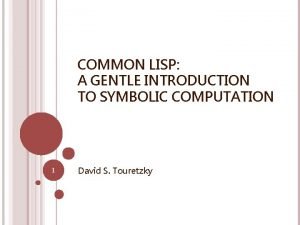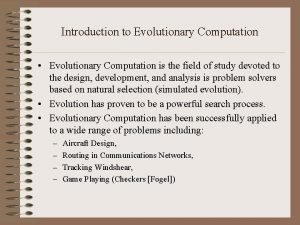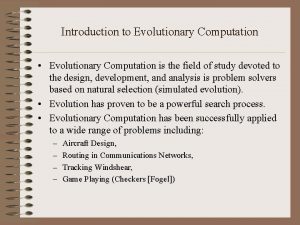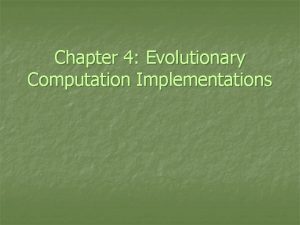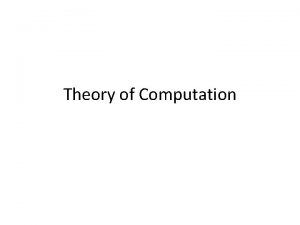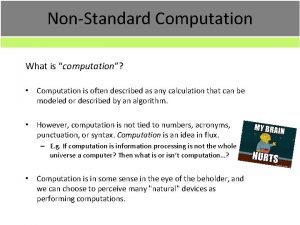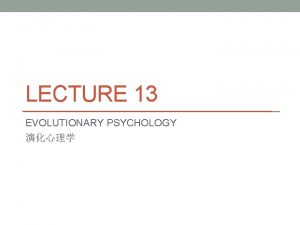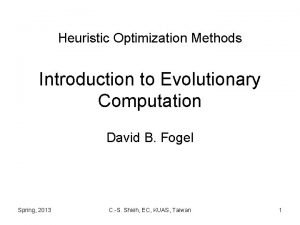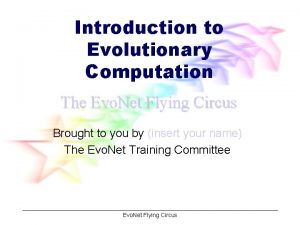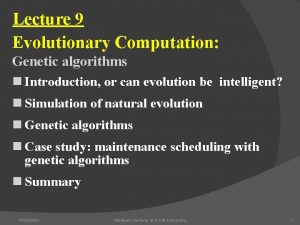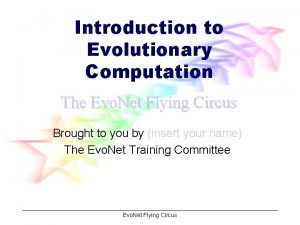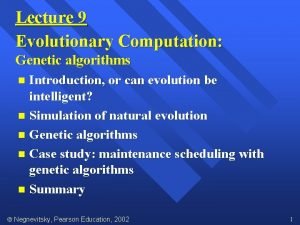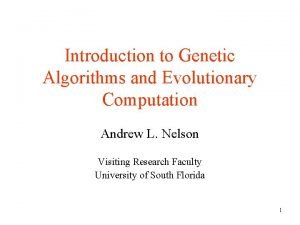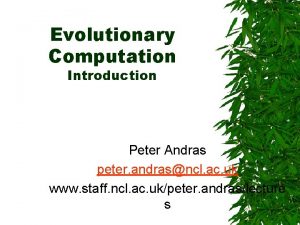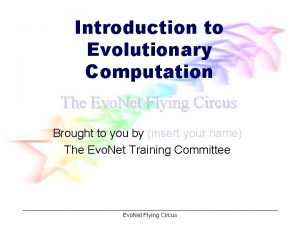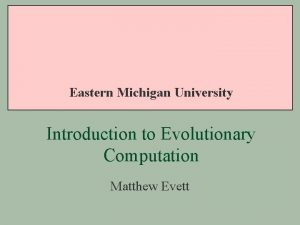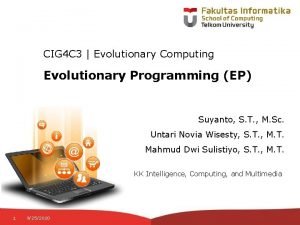Introduction to Evolutionary Computation Evolutionary Computation is the





















- Slides: 21

Introduction to Evolutionary Computation • Evolutionary Computation is the field of study devoted to the design, development, and analysis is problem solvers based on natural selection (simulated evolution). • Evolution has proven to be a powerful search process. • Evolutionary Computation has been successfully applied to a wide range of problems including: – – Aircraft Design, Routing in Communications Networks, Tracking Windshear, Game Playing (Checkers [Fogel])

Introduction to Evolutionary Computation (Applications cont. ) • • • Robotics, Air Traffic Control, Design, Scheduling, Machine Learning, Pattern Recognition, Job Shop Scheduling, VLSI Circuit Layout, Strike Force Allocation,

Introduction to Evolutionary Computation (Applications cont. ) • Theme Park Tours (Disney Land/World) http: //www. Touring. Plans. com • Market Forecasting, • Egg Price Forecasting, • Design of Filters and Barriers, • Data-Mining, • User-Mining, • Resource Allocation, • Path Planning, • Etc.

Introduction to Evolutionary Computation (cont. ) • An Example Evolutionary Computation Procedure EC{ t = 0; Initialize Pop(t); Evaluate Pop(t); While (Not Done) { Parents(t) = Select_Parents(Pop(t)); Offspring(t) = Procreate(Parents(t)); Evaluate(Offspring(t)); Pop(t+1)= Replace(Pop(t), Offspring(t)); t = t + 1; }

Introduction to Evolutionary Computation (cont. ) • In an Evolutionary Computation, a population of candidate solutions (CSs) is randomly generated. • Each of the CSs is evaluated and assigned a fitness based on a user specified evaluation function. The evaluation function is used to determine the ‘goodness’ of a CS. • A number of individuals are then selected to be parents based on their fitness. The Select_Parents method must be one that balances the urge for selecting the best performing CSs with the need for population diversity.

Introduction to Evolutionary Computation (cont. ) • The selected parents are then allowed to create a set of offspring which are evaluated and assigned a fitness using the same evaluation function defined by the user. • Finally, a decision must be made as to which individuals of the current population and the offspring population should be allowed to survive. Typically, in EC , this is done to guarantee that the population size remains constant. [The study of ECs with dynamic population sizes would make an interesting project for this course]

Introduction to Evolutionary Computation (cont. ) • Once a decision is made the survivors comprise the next generation (Pop(t+1)). • This process of selecting parents based on their fitness, allowing them to create offspring, and replacing weaker members of the population is repeated for a user specified number of cycles. • Stopping conditions for evolutionary search could be: – – – The discovery of an optimal or near optimal solution Convergence on a single solution or set of similar solutions, When the EC detects the problem has no feasible solution, After a user-specified threshold has been reached, or After a maximum number of cycles.

A Brief History of Evolutionary Computation • The idea of using simulated evolution to solve engineering and design problems have been around since the 1950’s (Fogel, 2000). – Bremermann, 1962 – Box, 1957 – Friedberg, 1958 • However, it wasn’t until the early 1960’s that we began to see three influential forms of EC emerge (Back et al, 1997): – Evolutionary Programming (Lawrence Fogel, 1962), – Genetic Algorithms (Holland, 1962) – Evolution Strategies (Rechenberg, 1965 & Schwefel, 1968),

A Brief History of Evolutionary Computation (cont. ) • The designers of each of the EC techniques saw that their particular problems could be solved via simulated evolution. – Fogel was concerned with solving prediction problems. – Rechenberg & Schwefel were concerned with solving parameter optimization problems. – Holland was concerned with developing robust adaptive systems.

A Brief History of Evolutionary Computation (cont. ) • Each of these researchers successfully developed appropriate ECs for their particular problems independently. • In the US, Genetic Algorithms have become the most popular EC technique due to a book by David E. Goldberg (1989) entitled, “Genetic Algorithms in Search, Optimization & Machine Learning”. • This book explained the concept of Genetic Search in such a way the a wide variety of engineers and scientist could understand apply.

A Brief History of Evolutionary Computation (cont. ) • However, a number of other books helped fuel the growing interest in EC: – Lawrence Davis’, “Handbook of Genetic Algorithms”, (1991), – Zbigniew Michalewicz’ book (1992), “Genetic Algorithms + Data Structures = Evolution Programs. – John R. Koza’s “Genetic Programming” (1992), and – D. B. Fogel’s 1995 book entitled, “Evolutionary Computation: Toward a New Philosophy of Machine Intelligence. • These books not only fueled interest in EC but they also were instrumental in bringing together the EP, ES, and GA concepts together in a way that fostered unity and an explosion of new and exciting forms of EC.

A Brief History of Evolutionary Computation: The Evolution of Evolutionary Computation • First Generation EC – EP (Fogel) – GA (Holland) – ES (Rechenberg, Schwefel) • Second Generation EC – – Genetic Evolution of Data Structures (Michalewicz) Genetic Evolution of Programs (Koza) Hybrid Genetic Search (Davis) Tabu Search (Glover)

A Brief History of Evolutionary Computation: The Evolution of Evolutionary Computation (cont. ) • Third Generation EC – – – – Artificial Immune Systems (Forrest) Cultural Algorithms (Reynolds) DNA Computing (Adleman) Ant Colony Optimization (Dorigo) Particle Swarm Optimization (Kennedy & Eberhart) Memetic Algorithms Estimation of Distribution Algorithms • Fourth Generation ? ?

Introduction to Evolutionary Computation: A Simple Example • Let’s walk through a simple example! • Let’s say you were asked to solve the following problem: – – – Maximize: f 6(x, y) = 0. 5 + (sin(sqrt(x 2+y 2))2 – 0. 5)/(1. 0 + 0. 001(x 2+y 2))2 Where x and y are take from [-100. 0, 100. 0] You must find a solution that is greater than 0. 99754, and you can only evaluate a total of 4000 candidate solutions (CSs) • This seems like a difficult problem. It would be nice if we could see what it looks like! This may help us determine a good algorithm for solving it.

Introduction to Evolutionary Computation: A Simple Example • A 3 D view of f 6(x, y):

Introduction to Evolutionary Computation: A Simple Example • If we just look at only one dimension f 6(x, 1. 0)

Introduction to Evolutionary Computation: A Simple Example • Let’s develop a simple EC for solving this problem • An individual (chromosome or CS) – <xi, yi> – fiti = f 6(xi, yi)

Introduction to Evolutionary Computation: A Simple Example Procedure simple. EC{ t = 0; Initialize Pop(t); /* of P individuals */ Evaluate Pop(t); while (t <= 4000 -P){ Select_Parent(<xmom, ymom>); /* Randomly */ Select_Parent(<xdad, ydad>); /* Randomly */ Create_Offspring(<xkid, ykid>): xkid = rnd(xmom, xdad) + Nx(0, ); ykid = rnd(ymom, ydad) + Ny(0, ); fitkid = Evaluate(<xkid, ykid>); Pop(t+1) = Replace(worst, kid); {Pop(t)-{worst}} {kid} t = t + 1; } }

Introduction to Evolutionary Computation: A Simple Example • To simulate this simple EC we can use the applet at: • http: //www. eng. auburn. edu/~gvdozier/GA. html

Introduction to Evolutionary Computation: A Simple Example • To get a better understanding of some of the properties of ECs let’s do the ‘in class’ lab found at: http: //www. eng. auburn. edu/~gvdozier/GA_Lab. html

Introduction to Evolutionary Computation: Reading List 1. 2. 3. Bäck, T. , Hammel, U. , and Schwefel, H. -P. (1997). “Evolutionary Computation: Comments on the History and Current State, ” IEEE Transactions on Evolutionary Computation, VOL. 1, NO. 1, April 1997. Spears, W. M. , De Jong, K. A. , Bäck, T. , Fogel, D. B. , and de Garis, H. (1993). “An Overview of Evolutionary Computation, ” The Proceedings of the European Conference on Machine Learning, v 667, pp. 442 -459. (http: //www. cs. uwyo. edu/~wspears/papers/ecml 93. pdf) De Jong, Kenneth A. , and William M. Spears (1993). “On the State of Evolutionary Computation”, The Proceedings of the Int'l Conference on Genetic Algorithms, pp. 618 -623. (http: //www. cs. uwyo. edu/~wspears/papers/icga 93. pdf)
 Union set operation
Union set operation Is etm recognizable
Is etm recognizable Common lisp: a gentle introduction to symbolic computation
Common lisp: a gentle introduction to symbolic computation Introduction to evolutionary computing
Introduction to evolutionary computing Hình ảnh bộ gõ cơ thể búng tay
Hình ảnh bộ gõ cơ thể búng tay Slidetodoc
Slidetodoc Bổ thể
Bổ thể Tỉ lệ cơ thể trẻ em
Tỉ lệ cơ thể trẻ em Chó sói
Chó sói Glasgow thang điểm
Glasgow thang điểm Alleluia hat len nguoi oi
Alleluia hat len nguoi oi Môn thể thao bắt đầu bằng chữ đua
Môn thể thao bắt đầu bằng chữ đua Thế nào là hệ số cao nhất
Thế nào là hệ số cao nhất Các châu lục và đại dương trên thế giới
Các châu lục và đại dương trên thế giới Công của trọng lực
Công của trọng lực Trời xanh đây là của chúng ta thể thơ
Trời xanh đây là của chúng ta thể thơ Mật thư tọa độ 5x5
Mật thư tọa độ 5x5 Làm thế nào để 102-1=99
Làm thế nào để 102-1=99 độ dài liên kết
độ dài liên kết Các châu lục và đại dương trên thế giới
Các châu lục và đại dương trên thế giới Thơ thất ngôn tứ tuyệt đường luật
Thơ thất ngôn tứ tuyệt đường luật Quá trình desamine hóa có thể tạo ra
Quá trình desamine hóa có thể tạo ra

